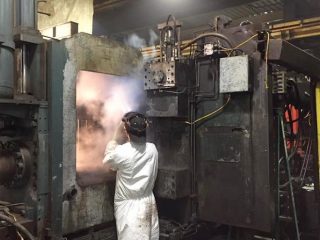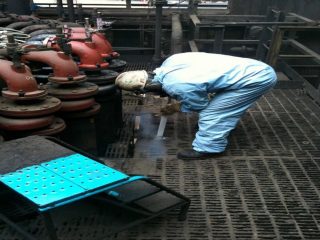Steel & Aluminium Industries
Cleaning of Stainless Steel, Steel, Aluminum, and Soft Metals:
Each of these metals requires a gentler approach to cleaning, and careful consideration must be made to not etch or profile their surface.
The cleaning process you choose to remove these contaminants must consider the level of clean required, if the area is inhabited by workers or the public, is lead or asbestos involved, if containment is required, and lastly your budget. These decisions must be carefully considered before a process is chosen. Our team of experienced and trained staff can assist you in choosing the method of cleaning that best suits your needs.
Examples of Stainless Steel, Steel, Aluminum, and Soft Metals to be cleaned:
- Kitchen equipment
- Food processing
- Instrumentation
- Processing equipment
- Machinery
- Electrical components
- Fans, venting, and ductwork
Very thorough surface preparation of Steel & Aluminum is essential if the coating scheme applied is to perform well. Steel & Aluminum, although when used in the marine industry is alloyed with magnesium, is a reactive metal, whose surface will react with atmospheric oxygen to form an almost invisible oxide layer. This occurs almost instantly on cutting or abrading and in damp marine environments a portion of the oxide will, in the passage of time, convert to the lighter and more visible hydroxide. Furthermore, steel & aluminum is prone to corrosion in a marine environment, particularly in confined spaces such as crevices and behind poorly adherent paint films. Therefore good surface protection is of paramount importance. Steel & Aluminum can suffer serious galvanic corrosion unless care is taken in the choice of underwater fittings, propellers etc. In this respect, the use of cuprous oxide or metallic flake containing antifouling should be avoided. Reference should be made to the section on Antifouling application
Degreasing
Before any other preparation commences, the steel & aluminum surface must be thoroughly degreased to remove flushing oils and other surface contamination. Solvent wiping using clean cloths can effectively degrease small areas, but these must be changed frequently to avoid re-distributing contaminants. Large areas should be degreased with a detergent such as Super Cleaner applied undiluted by cloth, allowed to “work’ for 15-20 minutes before removal with copious quantities of fresh water. Some areas may require repeated application, and vigorous cloth rubbing to remove all contamination. Alternatively a solvent may be used such as Degreaser. Once degreased, the surface must not be touched by hand until painted, in order to avoid grease spots and consequent paint detachment.
Electrical Applications using Dry Ice Blasting
Remove build up on electrical components in all types of electrical equipment. Applications include windings on generators, circuit boards, equipment motors and more. All cleaned without damage and minimal down time.
Summary
Surface preparation invariably involves blasting to a surface profile of 50-75 microns (2-3 mils). Prior to blasting:
- The surface should be degreased and weld splatter removed.
- Weld seams and sharp edges should be ground down to prevent too thin coatings being applied. The profile achieved will depend on the abrasive used, the air pressure and the blasting technique, Inadequate profile = Insufficient mechanical key. Excessive profile = Uneven coverage of sharp peaks.
- All debris must be removed by vacuum cleaning prior to painting.
- Compare blast profile to the standard photograph for color of steel.
- Measure Mean Apparent Amplitude (MAA) using the surface profile gauge making sure the aluminum is not shadowed, contaminated or containing embedded grit.










